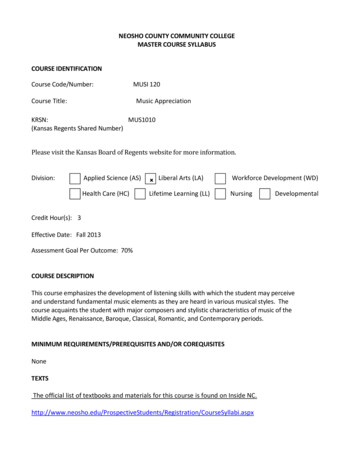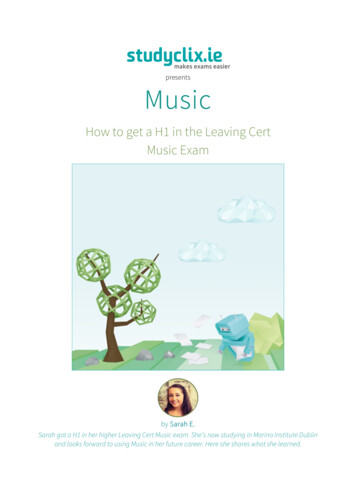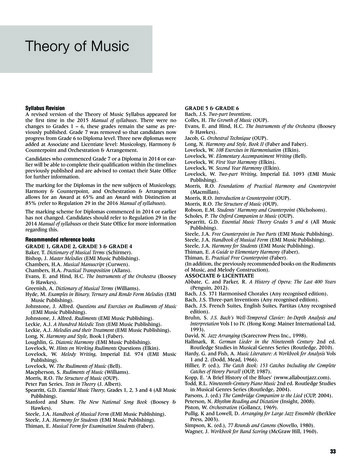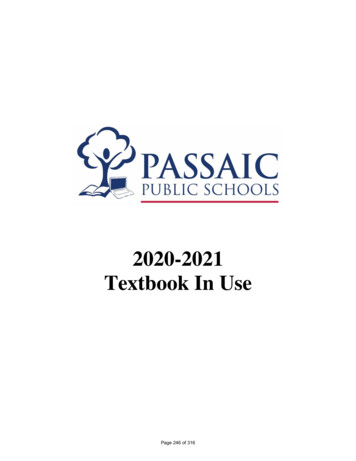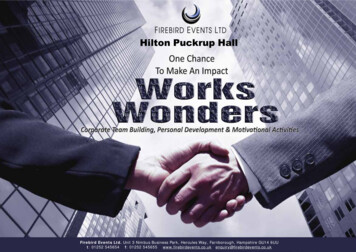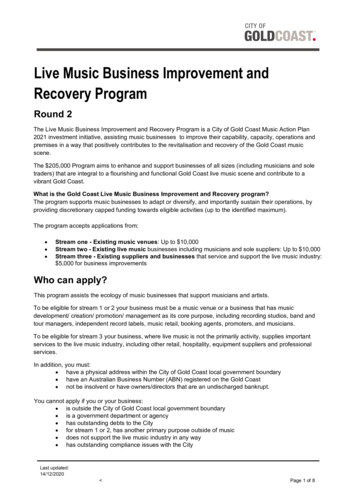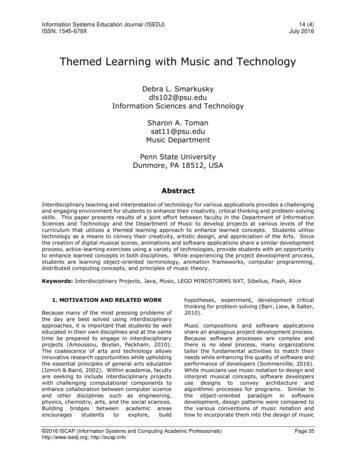
Transcription
Information Systems Education Journal (ISEDJ)ISSN: 1545-679X14 (4)July 2016Themed Learning with Music and TechnologyDebra L. Smarkuskydls102@psu.eduInformation Sciences and TechnologySharon A. Tomansat11@psu.eduMusic DepartmentPenn State UniversityDunmore, PA 18512, USAAbstractInterdisciplinary teaching and interpretation of technology for various applications provides a challengingand engaging environment for students to enhance their creativity, critical thinking and problem-solvingskills. This paper presents results of a joint effort between faculty in the Department of InformationSciences and Technology and the Department of Music to develop projects at various levels of thecurriculum that utilizes a themed learning approach to enhance learned concepts. Students utilizetechnology as a means to convey their creativity, artistic design, and appreciation of the Arts. Sincethe creation of digital musical scores, animations and software applications share a similar developmentprocess, active-learning exercises using a variety of technologies, provide students with an opportunityto enhance learned concepts in both disciplines. While experiencing the project development process,students are learning object-oriented terminology, animation frameworks, computer programming,distributed computing concepts, and principles of music theory.Keywords: Interdisciplinary Projects, Java, Music, LEGO MINDSTORMS NXT, Sibelius, Flash, Alice1. MOTIVATION AND RELATED WORKBecause many of the most pressing problems ofthe day are best solved using interdisciplinaryapproaches, it is important that students be welleducated in their own disciplines and at the sametime be prepared to engage in interdisciplinaryprojects (Amoussou, Boylan, Peckham, 2010).The coalescence of arts and technology allowsinnovative research opportunities while upholdingthe essential principles of general arts education(Izmirli & Baird, 2002). Within academia, facultyare seeking to include interdisciplinary projectswith challenging computational components toenhance collaboration between computer scienceand other disciplines such as engineering,physics, chemistry, arts, and the social sciences.Building bridges between academic areasencouragesstudentstoexplore,buildhypotheses, experiment, development criticalthinking for problem solving (Barr, Liew, & Salter,2010).Music compositions and software applicationsshare an analogous project development process.Because software processes are complex andthere is no ideal process, many organizationstailor the fundamental activities to match theirneeds while enhancing the quality of software andperformance of developers (Sommerville, 2016).While musicians use music notation to design andinterpret musical concepts, software developersuse designs to convey architecture andalgorithmic processes for programs. Similar tothe object-oriented paradigm in softwaredevelopment, design patterns were compared tothe various conventions of music notation andhow to incorporate them into the design of music 2016 ISCAP (Information Systems and Computing Academic Professionals)http://www.isedj.org; http://iscap.infoPage 35
Information Systems Education Journal (ISEDJ)ISSN: 1545-679Xnotation software (Brandorff, Lindholm &Christensen, 2005). An interdisciplinary musicand animation course with various technologiesfor object-oriented programming, music notationand animation presented a project developmentprocess (requirements, design, implementationand test/debug phases) that exists betweendisciplines (Smarkusky & Toman, 2009).Computing technology can be utilized to enhanceour creativity within the learning process.Students should have opportunities to engage ininterdisciplinary projects where they can buildconfidence and enhance their learning. Barkercompleted an interview study of both facultyresearch mentors and undergraduates lconditionsunderwhichundergraduate research was being conducted(Barker, 2009).Barker observed thatundergraduate research projects in science,technology, engineering, and mathematics(STEM) have benefits such as “improvedretention in both the major and discipline-relatedcareers; ability to work independently and tocommunicate well with a team; increasedconfidence in academic knowledge and technicalskill; broader awareness of the discipline; andawareness of career opportunities and support formaking career choices” (Barker, 2009).Replacing the traditional introductory computerscience course in the curriculum with aninterdisciplinary and “connected” pair of coursesin creative arts, humanities, history, math andcomputer science, natural sciences, and socialsciences has resulted in an increase in femaleenrollments, retention in computing, and . Connecting with Art courses in thecurriculum includes design (creativity) anddevelopment (computational thinking) (LeBlanc,Armstrong, & Gousie, 2010). An interdisciplinaryproject that requires computer science and musicmajors to develop a notation for playing a nonmusical instrument resulted in better appreciationof the importance of musical notation andsoftware syntax in both disciplines (Heines,Greher & Kuhn, 2009).Studentsmajoringincomputerscience,mechanical engineering, interactive multimediaand music designed and developed “ConductingRobots”, where a robotic and graphicalconducting system direct an orchestra andprovided an opportunity for students to focus oncritical thinking, creative problem solving, andcomputational thinking skills (Salgian, Ault,Nakra, Wang & Stone, 2011). Glasser asserted14 (4)July 2016that: being active while learning is better thanbeing inactive. Most people learn only 10% ofwhat they read, 20% of what they hear, 30% ofwhat they see, 50% of what they see and hear,70% of what they talk over with others, 80% ofwhat they use and do in real life and 95% whenthey teach someone else (Glasser, 1998).In the remaining sections of this paper, we specifythe technologies that were selected for thecompletion of our interdisciplinary projects whichincludeAlice,Flash,Sibelius,LEGO MINDSTORMS NXT, and leJOS.We thenprovide a summary of the projects that utilizethese technologies and discuss the scaffolding ofknowledge and support for enhancing learnedconcepts. We provide student comments aboutthese projects and conclude with studentfeedback and summary.2. MUSIC/ANIMATION TECHNOLOGIESAliceAlice (www.alice.org) is a freely availableprogramming environment for the teaching ofobject-orientedconceptsinintroductoryprogramming languages that was created anddistributed by Carnegie Mellon University(Cooper, Dann, & Pausch, 2000). The Aliceinterface, shown in Figure 1, provides informativeFigure 1. The Alice Interfacetutorials, a library of graphical components withembedded properties, methods and properties,camera controls, action events, and the ability toincorporate sound files all within an easy-to-learndrag-and-drop interface for the development ofanimations. 2016 ISCAP (Information Systems and Computing Academic Professionals)http://www.isedj.org; http://iscap.infoPage 36
Information Systems Education Journal (ISEDJ)ISSN: 1545-679XFlashAdobe Flash Professional (www.adobe.com) is adevelopmentenvironmentforcreatinganimations and multimedia content.Thisplatform provides students with the ability todevelop interactive media that focuses on designaspects such as scenes, frames, and timelinesand incorporates vector graphics, audio, imagesand scripting during development of mediaenhanced projects. An example of the FlashInterface is shown in Figure 2. This tool providesFigure 2. Flash Developer Interfacestudents with the ability to enhance their designexperience via graphic layers and frameworks tobetter prepare them for the design anddevelopment of Java FX projects.SibeliusSibelius (www.avid.com/US/products/sibelius) isa music notation application that is used bycomposers, arrangers, publishers, educators, andstudents to compose and write music. Sibelius,shown in Figure 3, provides users with a clickand-drag format for the insertion of musical notesand allows for instant playback of the musicalscore. This software application contains editingFigure 3. Sibelius Music Notation Application14 (4)July 2016tools for the management of notes, insertion oftext and graphics, selection of musicalinstruments, and utilization of an assortment ofbuilt-in sound plug-ins.LEGO MINDSTORMS NXTThe LEGO MINDSTORMS NXT platform,shown in Figure 4, provides the framework forstudents to experience software developmentusing sensor input, multiple software threads ofcomputation, and wireless communication. TheFigure 4. LEGO MINDSTORMS NXTNXT brick includes four sensor ports (‘1’, ‘2’, ‘3’,and ‘4’) and three input ports (‘A’, ‘B’, and ‘C’).LEGO offers a wide variety of sensors to include aSound Sensor, Light Sensor, NXT Color Sensorand Ultrasonic Sensor. Communication betweenthe computer and the NXT brick can be realizedwith a USB cable connection or programmed tousetheBluetooth (www.bluetooth.com)wireless communications. We elected to utilizethis technology due to the abundance of availabledocumentation, less expensive cost of the robotkits, and the extensible nature of the platform forvarious projects (LEGO MINDSTORMS EducationNXT, 2015).LeJOS NXJOriginally created from the TinyVM project, whichwas an implementation of a Java Virtual Machinefor LEGO MINDSTORMS RCX system, leJOSNXJ is a Java programming environment for theNXT (leJOS Team, 2009). This firmware is usedto replace the NXT factory-loaded software, .This leJOS NXJ environmentincludes a Java Virtual Machine, a library ofclasses that implement the NXJ ApplicationProgramming Interface (API) for execution on thebrick, a library of Java classes for computerprograms that communicate with the brick viaUSB or Bluetooth, PC tools for debugging and 2016 ISCAP (Information Systems and Computing Academic Professionals)http://www.isedj.org; http://iscap.infoPage 37
Information Systems Education Journal (ISEDJ)ISSN: 1545-679Xflashing the firmware, and the capability tocompile, link and upload programs and other filesto the NXT brick. The benefits of using leJOS NXJwas that it utilizes the Java programminglanguage and can be developed using .org)IntegratedDevelopmentEnvironment (IDE) with associated plugins forboth environments.Students enhance theirproblem-solving skills using object-oriented sed solutions.3. INTERDISCIPLINARY PROJECTSThe content contained in our music and animationprojects are presented in a scaffolding approachand utilize the seven principles for good practicein undergraduate education as presented byChickering and Gamson as shown in Table 1(Chickering & Gamson, 1987).Encourages contacts between students andfaculty.Develops reciprocity and cooperation amongstudents.Uses active learning techniques.Gives prompt feedback.Emphasizes time on task.Communicates high expectations.Respects diverse talents and ways of learning.Table 1. Principles for Undergraduate EducationKnowledge learned in earlier projects can bedirectly applied to concepts needed for futureprojects. Learning starts at the beginning of thecurriculum when the basic animation and objectoriented concepts are introduced using Alice.This learning continues with advanced design andanimation concepts in Flash and the compositionof digital music scores in Sibelius.Thisknowledge provides the foundation for the y projects using Java via LEGO MINDSTORMS NXT platform and leJOS. All ofthese projects provide students with a betterappreciation of the shared project developmentprocess that exists between programming,animation and music. In addition, these projectsprovide collaborative research and learningopportunities between disciplines, inspire ideasforadvancedcomputingprojectsusingmultimedia, and can be utilized as a platform forinterdisciplinary projects between technical andgeneral education courses.14 (4)July 2016Introductory Java CourseStudents in the Information Sciences andTechnology (IST) program first experienceinterdisciplinary projects in the IntroductoryProgramming Course, which can be completed inthe first or second semester of the curriculum.Students are learning the object-orientedterminology for the first time and Alice provides afun environment to familiarize students withthese concepts. Students are introduced to theAlice World and the associated gallery thatcontains classifications for the types of objectsthat can be added to a scene. Once objects areinstantiated (added to the scene), we discuss theproperties (attributes) and behaviors (methods)for each object shown in the Object Tree.Students also learn how to add sound effects andbackground music to enhance their animations.Each project provides students with anopportunity to be creative while learning theimportance of organizing concepts and behaviors.The creation of new methods allows students toreuse the code they had previously created inother areas of their animation, especially eventhandling.Logical structures provide variablebehaviors, while event-handling and cameracontrols provide a more interactive experience.Alice provides the perfect learning environmentfor which requirements definition, design,implementation and test/debug activities could beintroduced with instant visual feedback abouttheir performance.The project descriptionrepresents the requirements definition. Studentsidentify various classifications from the galleryand determine how they would be used in theanimation.For the implementation phase,students add instances of the objects to theworld, position them as specified in their design,and utilize the drag-and-drop interface of Alice tocreate new methods, events and logicalstructures to realize the required behaviors andactions of their animation. Students select theplay button to ensure correctness andcompleteness and make changes to the logic inmethods or placement of the object within thescene. The Alice environment provides a goodintroduction to object-oriented terminology,software development phases and the utilizationof sound files for special effects. Once studentscomplete several projects using Alice, they areintroduced to the Java programming language.General Education Arts CourseThe INART236 - Introduction to Music andAnimation with Technology course is a GeneralEducation Arts course that students areencouraged to complete after the secondsemester.The fundamental guidelines for a 2016 ISCAP (Information Systems and Computing Academic Professionals)http://www.isedj.org; http://iscap.infoPage 38
Information Systems Education Journal (ISEDJ)ISSN: 1545-679XGeneral Education course at our university statesthat the course “aids students in developingintellectual curiosity, strengthened ability tothink, and a deeper sense of aestheticappreciation” (Penn State University, 2012). Inthis course, Sibelius is utilized to aid in learningof music theory and the creation of a musicalscore, Flash allows students to realize morecomplex animation concepts, and a capstoneproject at the end of the course combines lessonslearned in both disciplines (Smarkusky & Toman,2009).The first six weeks of the semester focuses on thebasic fundamental concepts of music theory andcomposition using Sibelius.Learning therudiments of music requires an understanding ofeach of the elements of music before they cansing, play or write music notation.Thefundamental concepts of music theory iscomprised of notation, scales, meter, rhythm,intervals; and basic chord structure. As studentsare learning each of these music fundamentalsthey are working with technology via the interfaceof Sibelius to solve problems through activelearning exercises. These exercises, which arecreated in Sibelius, challenge the student’s abilityand knowledge about each learned concept. Theclick-and-drag interface of Sibelius allowsstudents to easily insert a musical note and itsrhythmic value into a digital music score. Inaddition to learning concepts of music theory andcomposition, students gain knowledge about awide variety of musical instruments that includestrings, woodwinds, brass, percussion, andkeyboard instruments. This knowledge providesstudents with the needed understanding to allowthem to incorporate staves for each of the newlyadded musical instruments during composition.In addition, Sibelius provides additional plug-insfor adding drum patterns, guitars, rhythmicpatterns, etc. The process of creating a musicalcomposition from scratch is a time consumingprocess of adding notes for a simple melody,chords for harmony, articulation and expressivenuances as well as instruments. It is a step-bystep process that must be followed correctly for asuccessful digital musical score. Music has oftenbeen compared to learning a foreign language.Students must learn and have an understandingof the basic music theory terminology to be ableto understand the more complex componentsrequired to complete a digital musical score.Students then learn to develop more complexanimations using Flash during the second sixweeks of the course.The Flash frameworkprovide students with an opportunity to designanimations that include timelines, scenes, layers,14 (4)July 2016and frames. Gridlines, rulers and guides provideguidance for the drawing of objects, creation ofsymbols or text components. Students learn howto create frame-by-frame animations, motion andshape tweens, and graphic symbol animations.The more advanced features include animatedtext, motion guide layers, mask layers, and theinclusion of sound. Interactive features includeframe labels and buttons with ActionScript beingutilized for more complex actions. Once again,students are gaining experience with the projectdevelopment process (Smarkusky & Toman,2009). To ensure that students are gainingexperience using a specific animation component,project descriptions and expected results areprovided for each exercise. During the designphase of the project, students need to identifyvarious scenes, determine layers, and theanimated effects that would occur at each frameof the timeline. Similar to creating graphical userinterfaces for their software developmentcourses, students need to focus on the design oftheir interface (scene) and layer components toachieve the desired result. Students design in atop-down approach and utilize a bottom-upapproach for implementation. Each animationcomponent is added to a layer, layers are addedto scenes, and scenes are integrated to create thefinal animation. Students play the animation tocheck that all requirements were satisfied andmake appropriate modifications when needed.During the last three weeks of the course,students are assigned a capstone project thatfocuses on combining knowledge gained in bothSibelius and Flash. The goal of the project is tocreate an animated greeting with backgroundmusic. For the music component of the project,the requirements definition is a simple andintroductory piece of sheet music, which isprovided to students for them to composedigitally using Sibelius. Students need to payspecific attention to detail to ensure that n, etc. match those in the requirementsdefinition. Students are allowed to enhance themusical piece by adding additional staves forvarious instruments as well as utilize a softwareplug-in to create a percussion part to enhance thestyle of their composition.Once testing iscompleted, students are required to export themusical score and convert the file to an MP3format for use in Flash.For the animation component, students mustsatisfy the specified technical components of theanimation while keeping within the theme of theassigned musical song. Technical requirementsinclude the addition of a separate layer for 2016 ISCAP (Information Systems and Computing Academic Professionals)http://www.isedj.org; http://iscap.infoPage 39
Information Systems Education Journal (ISEDJ)ISSN: 1545-679X14 (4)July 2016incorporating the sound file that was created inSibelius, creation of a new symbol, animated textblock with individual letter animation, use of amask layer, motion tweens, shape tweens, actionframes and labels, and button implementation toinclude ActionScript. The open-ended nature ofthe animation allows students to gain experiencein requirements definition and apply knowledgegained from active-learning and homeworkexercises to the design phase of the animation.Implementation and testing is an iterativeprocess as students need to ensure the frame-byframe execution of the project is correct to thatpoint of completion. The assessment for thisproject is based on the correctness andcompleteness of their musical composition, theircreativity in correlating the animation with thetheme of the music, and the correctimplementation of the technical components ofthe animation.preparation for a future project, students mustuse the sound sensor to start the robot in motion(e.g. a hand clap that is at least 25 decibels).Once in motion, the robot must follow a specifiedpath (Color1). Upon reaching the first wall, therobot should turn right 90 degrees and continuefollowing the path. When it reaches the secondwall with a different color (Color2), it will turn 180degrees and continue following the Color1 pathbackwards, keeping on a straight path whenpossible. Upon reaching the sand box (Color3),the robot will turn left 90 degrees and begin asearch pattern. The goal within the sandbox is tofind three additional color swatches (Color4,Color5, Color6), and play a unique sound for eachof the identified colors. The challenging nature ofthis project provides an opportunity for ing Interface (API), and gainingadditional experience with Java Threads.Advanced Java CourseDuring their junior year, IST students arerequired to complete a Distributed Computingcourse. One of the projects within this course isthe LEGO Maze Project as demonstrated in Figure5 (Smarkusky, Toman, Sutor & Hunt, 2013).Students gain experience with the leJOS interfaceOnce familiar with the leJOS API, sensors, and theability to maneuver the robot, IST students areassigned a project in which they must work withstudents from a General Education Music Theorycourse to create a robot dance where themovements of robot couples (two robots) aresynchronized to the rhythm of the music(Smarkusky & Toman, 2013).With thechoreography of the dance being the bridgebetween disciplines, the background music iscreated from scratch by the music students andthe robot dance movements are implemented bythe IST students.Figure 5. LEGO Maze Projectusing Java where they can compile, upload, andexecute programs on the LEGO MINDSTORMS NXT. Unlike traditional software projects thatobtain input from graphical user interfaces, filesor databases, this project utilizes input from thesound, color and ultrasonic sensors of the robot.The values read from the sound sensors areimpacted by environmental acoustics; robotmotors react differently based on the flooringsurface; color sensor values change with sunlight,shadows, natural or florescent lighting; andultrasonic senor values are constantly changingdue to range of vision and constant movement ofthe robot.This project requires that students utilize userdefined sound files or the onboard sound clipsthat are provided with the leJOS platform. InWithin the music theory course, students areintroduced to more complex characteristics ofmelody, rhythm, harmony, and instrumentation.Similar to the General Education Arts course,students start with a more advanced pianomusical score that is then created digitally usingSibelius. This project is further enhanced usingvarious instrumental parts to include flute,trumpet, saxophone, guitar, bass guitar, anddrum pattern plug-ins. Students are able tocontrol tempo, dynamics, and other musicnuances using the Sibelius’s integrated Playbackfeature.The IST students implement Java applications,utilizing the leJOS NXJ environment, to maneuverthe robots based on the steps identified in thechoreography which was also designed by themusic students. This provides unique learningopportunity for the IST students as they realizethe importance of threads and the completion ofobject-oriented methods for each routine withparameters for time, duration, direction, orrotation for various movements. The timeline 2016 ISCAP (Information Systems and Computing Academic Professionals)http://www.isedj.org; http://iscap.infoPage 40
Information Systems Education Journal (ISEDJ)ISSN: 1545-679Xthat is included with the Playback feature ofSibelius provided assistance with synchronizationof the robot dance movements to the music file.Assessment for this project is based on thecorrectness and completeness of the technicalrequirements of the project for each disciplinealong with the complexity of the choreographyand how well the movements were synchronizedto the music.Similar to the comparisonpresented by Do & Gross (Do & Gross, 2007), theprogrammer is not expected to be a musicstudent, and the music student is not expected tobe a programmer.Each member of theinterdisciplinary team utilizes their strengths forthe success of the project.4. FEEDBACK AND SUMMARYOverall, the results of incorporating a musicaltheme to allow students to learn technicalconcepts was a positive experience.At thefreshman level, Alice provided a platform toexcite students about music and animation, theproject development process, and object-orientedterminology, as a preamble to the developmentof projects using Java. During the sophomoreyear, students were encouraged to enroll in theGeneral Education Arts course in music andanimation.Since the development of digitalmusical scores, animations, and softwareapplications follow a similar project developmentprocess, the completion of this course providedstudents with opportunities to understand theimportance of paying attention to details (withinSibelius and Flash), learning how the projectdevelopment process can be applied to otherdisciplines, and providing students with anopportunity to learn more about designinginterfaces using layers that will provide afoundation for the learning Java FX in future Javaprogramming courses.The General Arts Education course was offered inthe Fall 2013 semester. This course had anenrollment of 20 with 14 students electing tocomplete an optional survey. As shown in Table2 of the Appendix, and represented below withactual student comments, the students enjoyedusing various technologies, had a betterunderstanding of the project developmentprocess, increased their creative abilities, gainedconfidence with the application of learnedconcepts to other disciplines, and had anincreased appreciation for the attention to detailand time involved with creating musicalanimations.“Completing my music and animation projectdid change my perception of music,14 (4)July 2016animation, and technology. It was prettytechnical to make pieces of music oranimation, yet putting it all together was alittle difficult, yet challenging and fun.”“When I look at music and animation, I seehow much work goes into it and I enjoy itmuch more. I now see the bigger picture andsee that you can get very creative with it ifthey are willing to learn.”“Music is good for teaching logic andanimation can teach patience. Also, they bothcan give students an edge with some jobs.”“I think the arts are an underappreciatedaspect of our culture and music andanimation go hand in hand today. You don'thave to go far to see some greatachievements online using a combination ofthese. I would definitely say that getting anintroduction into the complexity to gainappreciation for it is a good idea.”Since students required more experience withJava to include concurrent threads of control andprogramming with limited resources, we electedto wait until the advanced Java course for theapplicationofprojectsusingLEGO MINDSTORMS NXT and the leJOS firmware.Assigning the LEGO Maze project as requiredproject in the course, allowed students to gainexperience and confidence with these newtechnologies prior to being paired with the musictheory students for the completion of the LEGODance project. Using the leJOS programming todevelop programs for the NXT can challenge one’ssoftwaredevelopment,robotics,andprogramming skills. The LEGO Dance projectincorporated a new perspective to the softwaredevelopment process in that students nowneededtoimplementtherequirements(choreography) that were designed by the musictheory students, and be able to explain thelimitations of the technology and the project(keeping two robots on a 6’x12’ floor surface,implementing moves via two robot wheels andnot actual human feet, etc.). The expectations ofboth the IST and music students were high, sothey worked together as a team to complete andsolve the challenges of this project. At the end ofthe project, we surveyed all students, both musicand IST, to get their feedback.We haveincorporated the LEGO Maze and LEGO DanceProject into the advanced Java course everyspring semester since 2012.The combinedfeedback for the LEGO Dance Project over thepast four years with 96 students participating is 2016 ISCAP (Information Systems and Computing Academic Professionals)http://www.isedj.org; http://iscap.infoPage 41
Information Systems Education Journal (ISEDJ)ISSN: 1545-679Xshown in Table 3 of the Appendix, and includesresponses from both Music and IST students.The results demonstrate that the LEGO DanceProject was a success. Students were able toexpress their creativity, enjoyed working withstudents from other disciplines, learned moreabout animation and recommended that thisproject be offered again in the future. The projectteams consisted
various projects (LEGO MINDSTORMS Education NXT, 2015). LeJOS NXJ Originally created from the TinyVM project, which was an implementation of a Java Virtual Machine for LEGO MINDSTORMS RCX system, leJOS NXJ is a Java programming environment for the NXT (leJOS Team, 2009). This firmware is used to replace the NXT factory-loaded software, which
